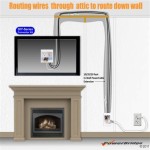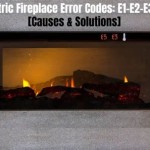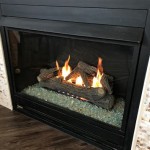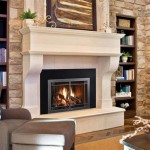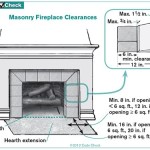Where Do You Plug In An Electric Fireplace Insert? A Comprehensive Guide
Electric fireplace inserts offer a convenient and aesthetically pleasing way to add supplemental heat and ambiance to a home. Unlike traditional fireplaces, they require no venting or fuel lines, making installation relatively simple. However, a crucial aspect of installation is understanding the electrical requirements and knowing precisely where to plug in the unit. This guide provides a comprehensive overview of the electrical considerations and proper connection procedures for electric fireplace inserts.
Electric fireplace inserts operate by converting electrical energy into heat using a resistance heating element. They also incorporate components like a fan to circulate the warmed air and lights to simulate a realistic flame effect. These components collectively draw a significant amount of power, necessitating careful attention to the electrical circuit to which the insert is connected.
The primary consideration when determining where to plug in an electric fireplace insert revolves around the voltage and amperage requirements of the unit. These specifications are typically provided by the manufacturer and can be found on a label affixed to the insert itself or within the product's user manual. Neglecting these specifications can lead to electrical hazards and damage to the appliance.
Understanding Voltage and Amperage Requirements
Most electric fireplace inserts are designed to operate on a standard 120-volt alternating current (VAC) power supply, which is the typical voltage found in most residential outlets in North America. However, larger and more powerful models may require a 240 VAC connection. This higher voltage is commonly used for appliances with higher power demands, such as electric dryers and ovens. Using the incorrect voltage can immediately damage the unit.
Amperage (amps) refers to the amount of electrical current drawn by the device. Electric fireplace inserts will have a specific amperage rating, indicating the maximum current the unit will draw during operation. This amperage rating is critical because it determines the appropriate circuit breaker size and the gauge (thickness) of wiring required to safely power the insert.
Overloading a circuit can lead to overheating of the wires, potentially causing a fire. Therefore, it is imperative to ensure that the circuit breaker and wiring are adequately sized to handle the amperage load of the electric fireplace insert, in addition to any other appliances or devices already connected to the same circuit.
To determine the total amperage draw on a circuit, sum the amperage ratings of all devices connected to the circuit. If the total amperage exceeds the circuit breaker's rating (typically 15 or 20 amps for a standard 120 VAC circuit), it is necessary to either connect the electric fireplace insert to a different circuit or upgrade the existing circuit to a higher amperage rating. Consulting with a qualified electrician is highly recommended when dealing with circuit upgrades.
Identifying Suitable Outlets and Circuitry
The most common and straightforward method of connecting an electric fireplace insert is to plug it directly into a standard wall outlet. However, not all outlets are created equal. It is crucial to assess the outlet and the circuit to which it is connected before plugging in the insert.
First, visually inspect the outlet for any signs of damage, such as cracks, discoloration, or loose connections. A damaged outlet can pose a fire hazard and should be replaced by a qualified electrician. Similarly, check the wiring behind the outlet, if accessible, for any signs of deterioration or improper installation. Older wiring may not be able to handle the amperage load of an electric fireplace insert, particularly if it's a high-wattage model.
Next, determine which circuit breaker controls the outlet you intend to use. This can typically be accomplished by turning off breakers one at a time until the outlet loses power. Once you have identified the correct breaker, examine its amperage rating. As mentioned previously, the breaker rating should be higher than the amperage draw of the electric fireplace insert, plus any other appliances connected to the same circuit.
It is generally advisable to plug the electric fireplace insert into an outlet that is not shared with other high-power appliances, such as refrigerators, microwaves, or air conditioners. These appliances can draw significant amounts of power, leaving insufficient capacity for the fireplace insert and potentially causing the circuit breaker to trip frequently.
If the available outlets are not suitable or if you are unsure about the electrical capacity of your existing circuits, it is best to have a dedicated circuit installed specifically for the electric fireplace insert. A dedicated circuit provides a safe and reliable power source for the appliance, ensuring that it operates without overloading the existing electrical system.
Ground fault circuit interrupter (GFCI) outlets are often found in bathrooms and kitchens, near water sources. While it is technically possible to plug an electric fireplace insert into a GFCI outlet, it is generally not recommended. GFCI outlets are designed to trip if they detect a ground fault, which can occur if there is a short circuit or if electricity is leaking to ground. While this is a safety feature, it can also cause nuisance tripping, interrupting the operation of the fireplace insert unnecessarily.
Extension Cords, Surge Protectors, and Other Considerations
The use of extension cords with electric fireplace inserts is generally discouraged, especially for extended periods. Extension cords are often not designed to handle the high amperage load of these appliances, and their use can lead to overheating, voltage drops, and even fire hazards. If an extension cord is absolutely necessary, it must be a heavy-duty cord with a gauge rating sufficient to handle the amperage draw of the fireplace insert. The cord should also be kept as short as possible to minimize voltage drop.
Surge protectors are designed to protect electronic devices from voltage spikes and surges that can damage sensitive components. While surge protectors can provide some level of protection for electric fireplace inserts, they are not a substitute for proper electrical wiring and circuit protection. If you choose to use a surge protector, ensure that it is rated for the amperage and voltage requirements of the fireplace insert.
It is also important to avoid plugging the electric fireplace insert into a multi-outlet power strip, especially if other high-power devices are connected to the same power strip. Power strips are often not designed to handle the combined amperage draw of multiple appliances, and their use can lead to overheating and fire hazards. A dedicated outlet or a heavy-duty surge protector is a safer option.
The location of the outlet relative to the fireplace insert should also be considered. Ideally, the outlet should be located within easy reach of the fireplace insert's power cord, without requiring the cord to be stretched or strained. A strained power cord can be damaged over time, increasing the risk of electrical hazards. If the outlet is not conveniently located, it may be necessary to relocate or install a new outlet closer to the fireplace insert location. This work should be performed by a qualified electrician.
Regularly inspect the power cord of the electric fireplace insert for any signs of damage, such as cuts, fraying, or exposed wires. A damaged power cord should be replaced immediately by a qualified technician to prevent electrical shock or fire hazards. Do not attempt to repair a damaged power cord yourself, as this can be extremely dangerous.
In general, when in doubt about any aspect of the electrical installation of an electric fireplace insert, it is always best to consult with a qualified electrician. A licensed electrician can assess your existing electrical system, determine the appropriate wiring and circuit protection requirements, and ensure that the installation is performed safely and in accordance with all applicable electrical codes.

ᑕ❶ᑐ How To Install An Electric Fireplace Insert Magikflame Blog

Electric Fireplace Insert Plug In Firebox 1 866 966 1122
How To Install An Electric Fireplace Insert

How To Install An Electric Fireplace Insert Step By Guide

How To Install An Electric Fireplace Insert In Existing

How To Install A Fireplace Insert In An Unconventional Opening Ask This Old House

ᑕ❶ᑐ Installing An Electric Fireplace Insert Into A Cabinet

How To Install A Napoleon Built In Electric Fireplace Fireplaces Direct Learning Center

Recessed Or Wall Mount Electric Fireplace Installations Explained Touchstone Home S Inc

Dimplex 23 Multi Fire Xhd Plug In Electric Firebox Insert Logs Xhd23l Fireplaces Depot
Related Posts

